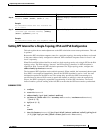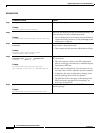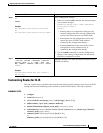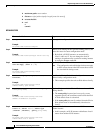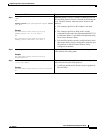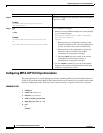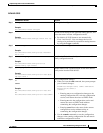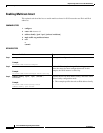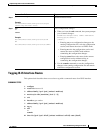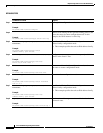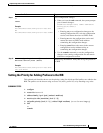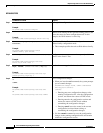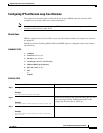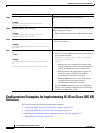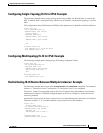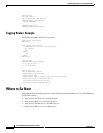
Implementing IS-IS on Cisco IOS XR Software
How to Implement IS-IS on Cisco IOS XR Software
RC-309
Cisco IOS XR Routing Configuration Guide
OL-14356-01
Tagging IS-IS Interface Routes
This optional task describes how to associate a tag with a connected route of an IS-IS interface.
SUMMARY STEPS
1. configure
2. router isis instance-id
3. address-family {ipv4 | ipv6} [unicast | multicast]
4. metric-style wide [transition] [level {1 | 2}]
5. exit
6. interface type number
7. address-family {ipv4 | ipv6} [unicast | multicast]
8. tag tag
9. end
or
commit
10. show isis [ipv4 | ipv6 | afi-all] [unicast | multicast | safi-all] route [detail]
Step 4
mpls traffic-eng multicast-intact
Example:
RP/0/RP0/CPU0:router(config-isis-af)# mpls
traffic-eng multicast-intact
Enables multicast-intact.
Step 5
end
or
commit
Example:
RP/0/RP0/CPU0:router(config-isis-af)# end
or
RP/0/RP0/CPU0:router(config-isis-af)# commit
Saves configuration changes.
• When you issue the end command, the system prompts
you to commit changes:
Uncommitted changes found, commit them before
exiting(yes/no/cancel)?
[cancel]:
–
Entering yes saves configuration changes to the
running configuration file, exits the configuration
session, and returns the router to EXEC mode.
–
Entering no exits the configuration session and
returns the router to EXEC mode without
committing the configuration changes.
–
Entering cancel leaves the router in the current
configuration session without exiting or
committing the configuration changes.
• Use the commit command to save the configuration
changes to the running configuration file and remain
within the configuration session.
Command or Action Purpose



